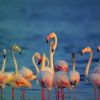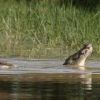බන්දුල ජාතික උද්යානය
Haven for migrant and resident birds and for it's wetland habitat Bundala is most famous for its migratory and resident birds and the only one Ramsar site in Sri Lanka.
The migration period from August with the commencement of the harsh winter and continues up to mid - April, when the Southern Hemisphere " attracts " them with plenty of food and sunshine. Situated around 250KM south east of Colombo, The 6200ha park Bundala was first declared as a Sanctuary in 1969 and now a national park. The most significant aspect is its 20000 or more shorebirds residing at Bundala from August to April each year.
This unique are of picturesque lagoons and intertidal mudflats where the wintering birds rest and feed, golden beaches and sand dunes frequented by nesting sea turtles and throny scrub jungle where elephant. Deer and wild buffalo roam is also a paradise 149 species of resident and migratory birds.
There are birds of Eastern Europe inhabitants of the tundra of the Siberian region. The Flamingo comes from neighbouring India.
Bundala National Park is an internationally important wintering ground for migratory water birds in Sri Lanka. Bundala harbors 197 species of birds, the highlight being the greater flamingo, which migrate in large flocks.[1] Bundala was designated a wildlife sanctuary in 1969 and redesignated to a national park on 4 January 1993.[2] In 1991 Bundala became the first wetland to be declared as a Ramsar site in Sri Lanka. In 2005 the national park was designated as a biosphere reserve by UNESCO, the fourth biosphere reserve in Sri Lanka.[3] The national park is situated 245 kilometres (152 mi) southeast of Colombo.
Location Southern Province, Sri Lanka
Nearest city Hambantota
Coordinates 6°12′50″N 81°13′30″ECoordinates: 6°12′50″N 81°13′30″E
Area 3,339.38 hectares (12.8934 sq mi) after regazzetting in 2004, originally of 6,216 hectares (24.00 sq mi)[1]
Established 1969 (Sanctuary)
1993 (National park)
Governing body Department of Wildlife Conservation
Listing Details
Address
තිස්සමහාරාම පාර, හමිබන්තොට, ශ්රී ලංකාව







